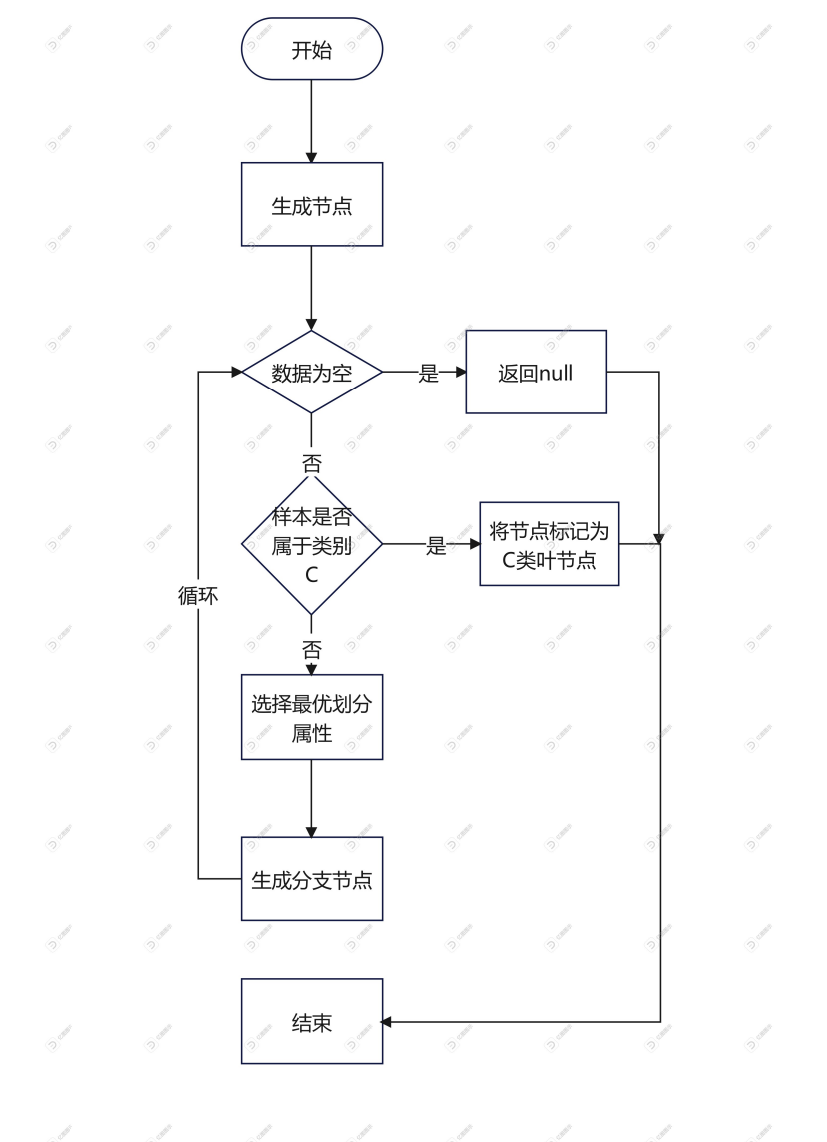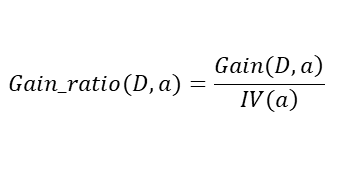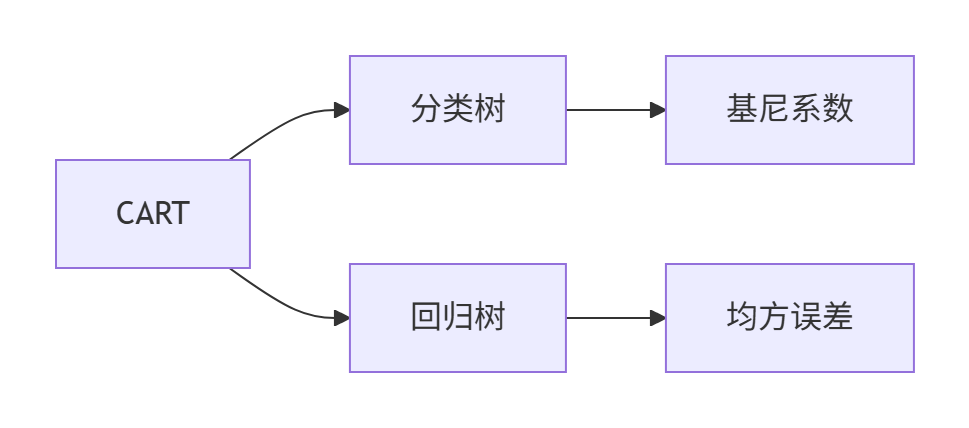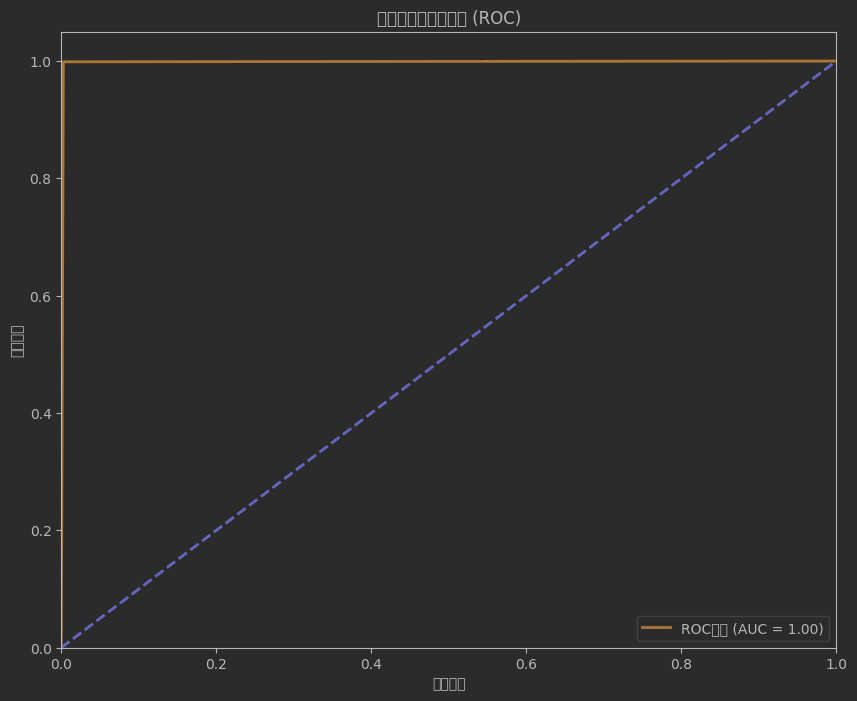机器学习【五】decision_making tree
决策树是一种通过树形结构进行数据分类或回归的直观算法,其核心是通过层级决策路径模拟规则推理。主要算法包括:ID3算法基于信息熵和信息增益选择划分属性;C4.5算法改进ID3,引入增益率和剪枝技术解决多值特征偏差;CART算法采用二叉树结构,支持分类(基尼系数)与回归(方差)任务。信用卡欺诈检测案例实践展示了全流程应用:通过SMOTE处理样本不平衡,转换时间特征及标准化数值完成数据预处理;利用网格搜索优化模型参数,可视化特征重要性与树结构;设置动态阈值平衡误报与漏报率,最终部署为实时检测系统并定期更新模型。该案例验证了决策树在复杂业务场景中的解释性与工程落地价值。
1 案例导学
想象你玩“20个问题”猜动物游戏:
问1:是哺乳动物吗?→ 是
问2:有尾巴吗?→ 是
问3:生活在水中吗?→ 否
...
最后得出答案是狗🐕
决策树就是一套自动生成这种“问题流程”的算法,专治选择困难症!
2 决策树
决策树(Decision Tree),它是一种以树形数据结构来展示决策规则和分类结果的模型,作为一种归纳学习算法,其重点是将看似无序、杂乱的已知数据,通过某种技术手段将它们转化成可以预测未知数据的树状模型,每一条从根结点(对最终分类结果贡献最大的属性)到叶子结点(最终分类结果)的路径都代表一条决策的规则。
当构建好决策树后,那么分类和预测的任务就很简单了,只需要走一遍就可以了,那么难点就在于如何构造出一棵树。
构建流程

- 首先从开始位置,将所有数据划分到一个节点,即根节点。
- 然后经历橙色的两个步骤,橙色的表示判断条件:
- 若数据为空集,跳出循环。如果该节点是根节点,返回null;如果该节点是中间节点,将该节点标记为训练数据中类别最多的类
- 若样本都属于同一类,跳出循环,节点标记为该类别;
- 如果经过橙色标记的判断条件都没有跳出循环,则考虑对该节点进行划分。既然是算法,则不能随意的进行划分,要讲究效率和精度,选择当前条件下的最优属性划分(什么是最优属性,这是决策树的重点,后面会详细解释)
- 经历上步骤划分后,生成新的节点,然后循环判断条件,不断生成新的分支节点,直到所有节点都跳出循环。
- 结束。这样便会生成一棵决策树。
在执行决策树生成的过程中,我们发现寻找最优划分属性是决策树过程中的重点。那么如何在众多的属性中选择最优的呢?下面我们学习三种算法。
3 ID3算法
ID3算法最早是由罗斯昆于1975提出的一种决策树构建算法,算法的核心是“信息熵”。该算法是以信息论为基础,以信息增益为衡量标准,从而实现对数据的归纳分类。而实际的算法流程是计算每个属性的信息增益,并选取具有最高增益的属性作为给定的测试属性。
3.1 信息熵
熵就是表示随机变量不确定性的度量,物体内部的混乱程度。熵越大,系统越混乱。
信息熵公式如下:

X: 代表一个离散随机变量,它有
n个可能的结果(或状态)。例如:抛硬币的结果(正、反),掷骰子的点数(1到6),明天天气的类型(晴、雨、阴等),一个英文文本中的字母。pᵢ: 代表随机变量
X取第i个可能结果发生的概率。例如,抛一枚公平硬币,p(正面) = p(反面) = 0.5。掷一个公平骰子,p(点数为k) = 1/6。∑ (i=1 到 n): 表示对所有可能的结果(从1到n)进行求和。
log: 通常取以2为底的对数 (log₂)。单位是比特 (bit)。有时也取自然对数 (ln),单位是纳特 (nat)。
pᵢ log pᵢ: 这一项衡量了单个结果 i 所贡献的“惊奇度”或“信息量”。注意,因为概率
pᵢ在0到1之间,所以log pᵢ是负数(或零)。因此,我们加了一个负号-。- pᵢ log pᵢ: 负号使这个量变成了非负数。
pᵢ log pᵢ本身是个负值(因为概率小于等于1,其对数小于等于0),加上负号后就变成了正值。-pᵢ log pᵢ可以理解为结果i发生所能提供的期望信息量(基于其概率)。H(X): 对所有可能结果的
-pᵢ log pᵢ求和,得到的就是 X 的熵H(X)。它代表了描述随机变量X(平均意义上)所需要的最小信息量(以比特或纳特为单位),或者更根本地说,是X本身的平均不确定性的度量。
信息熵就是“万物皆有其不确定性的数学度量”。它告诉我们,要描述一个不确定的东西,平均最少要多少信息。这个数字越大,那件事情就越“难猜”,越“出乎意料”。从扔硬币到宇宙的复杂度,信息熵为我们理解随机性和信息本身提供了一个强有力的量化工具。
我们按照某一个属性对数据进行划分以后,得到第二个信息熵。

了解了信息熵以后,我们接下来认识一下信息增益。
3.2 信息增益
信息增益:表示特征X使得类Y的不确定性减少的程度,分类后的专一性,希望分类后的结果是同类在一起。

其实就是划分前的信息熵减去划分后的信息熵。其中a代表的此次划分中所使用的属性。决策树使用信息增益准则来选择最优划分属性的话,在划分前会针对每个属性都计算信息增益,选择能使得信息增益最大的属性作为最优划分属性。
3.3 代码实现
以“是否适合打网球”为例子简单实现一下使用ID3的决策树
# 使用ID3算法
import numpy as np
import math
from collections import Counterclass Node:"""决策树节点类"""def __init__(self, feature=None, value=None, results=None, children=None):self.feature = feature # 分割特征的索引self.value = value # 特征值(用于判断分支)self.results = results # 叶节点的分类结果self.children = children # 子节点字典{特征值: 节点}def entropy(data):"""计算数据集的信息熵"""labels = [row[-1] for row in data]label_counts = Counter(labels)probs = [count / len(labels) for count in label_counts.values()]return -sum(p * math.log2(p) for p in probs)def split_data(data, feature_index, value):"""按指定特征分割数据集"""return [row for row in data if row[feature_index] == value]def information_gain(data, feature_index):"""计算特征的信息增益"""base_entropy = entropy(data)feature_values = {row[feature_index] for row in data}new_entropy = 0.0for value in feature_values:subset = split_data(data, feature_index, value)prob = len(subset) / len(data)new_entropy += prob * entropy(subset)return base_entropy - new_entropydef find_best_feature(data):"""寻找信息增益最大的特征"""best_gain = 0.0best_feature = -1# 最后1列是标签,所以特征索引是0到len-2for feature_index in range(len(data[0]) - 1):gain = information_gain(data, feature_index)if gain > best_gain:best_gain = gainbest_feature = feature_indexreturn best_featuredef build_tree(data, feature_names):"""递归构建决策树"""# 如果所有样本属于同一类别,返回叶节点labels = [row[-1] for row in data]if len(set(labels)) == 1:return Node(results=labels[0])# 选择最佳分割特征best_feature_idx = find_best_feature(data)if best_feature_idx == -1: # 如果没有特征可选majority_label = Counter(labels).most_common(1)[0][0]return Node(results=majority_label)# 递归构建子树feature_name = feature_names[best_feature_idx]unique_vals = {row[best_feature_idx] for row in data}children = {}for value in unique_vals:subset = split_data(data, best_feature_idx, value)children[value] = build_tree(subset, feature_names)return Node(feature=feature_name, children=children)def print_tree(node, indent=""):"""打印决策树结构"""if node.results is not None:print(indent + "结果:", node.results)else:print(indent + "特征:", node.feature)for value, child in node.children.items():print(indent + "├── 分支:", value)print_tree(child, indent + "│ ")# 数据集格式: [Outlook, Temperature, Humidity, Windy, PlayTennis]
data = [['Sunny', 'Hot', 'High', 'Weak', 'No'],['Sunny', 'Hot', 'High', 'Strong', 'No'],['Overcast', 'Hot', 'High', 'Weak', 'Yes'],['Rain', 'Mild', 'High', 'Weak', 'Yes'],['Rain', 'Cool', 'Normal', 'Weak', 'Yes'],['Rain', 'Cool', 'Normal', 'Strong', 'No'],['Overcast', 'Cool', 'Normal', 'Strong', 'Yes'],['Sunny', 'Mild', 'High', 'Weak', 'No'],['Sunny', 'Cool', 'Normal', 'Weak', 'Yes'],['Rain', 'Mild', 'Normal', 'Weak', 'Yes'],['Sunny', 'Mild', 'Normal', 'Strong', 'Yes'],['Overcast', 'Mild', 'High', 'Strong', 'Yes'],['Overcast', 'Hot', 'Normal', 'Weak', 'Yes'],['Rain', 'Mild', 'High', 'Strong', 'No']
]feature_names = ['Outlook', 'Temperature', 'Humidity', 'Windy']# 构建决策树
decision_tree = build_tree(data, feature_names)# 打印决策树
print("构建的决策树结构:")
print_tree(decision_tree)构建的决策树结构:
特征: Outlook
├── 分支: Overcast
│ 结果: Yes
├── 分支: Rain
│ 特征: Windy
│ ├── 分支: Weak
│ │ 结果: Yes
│ ├── 分支: Strong
│ │ 结果: No
├── 分支: Sunny
│ 特征: Humidity
│ ├── 分支: Normal
│ │ 结果: Yes
│ ├── 分支: High
│ │ 结果: No
3.4 优缺点分析
3.4.1 优点
- 直观易理解 决策树结构直观反映了特征重要性(根节点即最重要特征)
- 计算复杂度较低 训练时间复杂度为O(n * d * log n),n为样本数,d为特征数
- 不需要数据预处理 天然支持离散特征(连续特征需离散化)能自动处理多类别问题
- 特征选择能力强 使用信息增益自动选择重要特征
3.4.2 缺点
- 过拟合风险高 会不断分裂直到完美拟合训练数据 对噪声敏感,容易学习到训练数据中的随机波动
- 倾向选择多值特征 信息增益偏向选择取值更多的特征(更多分支导致熵减少更多)
- 不直接支持连续特征 需要预处理将连续特征离散化
- 缺少全局优化 采用贪心算法(每次选局部最优特征),非全局最优树 对数据小变化敏感.
- 类别不平衡问题信息增益在类别不平衡数据中可能偏差
4 C4.5算法
C4.5算法是ID3算法的改进。用信息增益率来选择属性。在决策树构造过程中进行减枝,可以对非离散数据和不完整的数据进行处理。
我们想象你在商场做促销活动策划,现在有两个选择:
选择1:按会员卡号分组 → 每组1人(信息增益最大)
选择2:按消费等级分组 → 每组人数适中
ID3会选方案1,因为每个会员都是"纯分组",但这实际毫无价值!C4.5就是为了解决这种问题而诞生的。
4.1 增益率
增益率公式:

其中分裂信息:

通俗理解:
原始信息增益是"奖励",分裂信息是"惩罚"(当特征取值过多时惩罚加重)
就像公司发奖金时,既要看业绩(增益),也要考虑工作难度系数(分裂信息)
4.2 剪枝技术
C4.5采用悲观错误剪枝(PEP):
计算节点误差上限:

比较子树和叶节点的预期误差
当剪枝后预期误差不增加时,剪掉子树
✂️ 剪枝哲学:
"与其保留可能出错的分支,不如当机立断截肢"
4.3 代码实现
# 使用c4.5算法
import numpy as np
import math
from collections import Counterclass Node:"""决策树节点类(C4.5版本)"""def __init__(self, feature=None, threshold=None, value=None, results=None, children=None):self.feature = feature # 分割特征名称self.threshold = threshold # 连续特征的分割阈值(仅用于连续特征)self.value = value # 特征值(用于离散特征分支判断)self.results = results # 叶节点的分类结果self.children = children # 子节点字典{特征值/区间: 节点}class C45DecisionTree:"""C4.5决策树实现"""def __init__(self, min_samples_split=2, max_depth=5):self.min_samples_split = min_samples_split # 最小分裂样本数self.max_depth = max_depth # 树的最大深度self.root = None # 决策树根节点self.feature_types = {} # 存储特征类型(离散/连续)def fit(self, data, feature_names, target_name):"""构建决策树"""self._determine_feature_types(data, feature_names)self.root = self._build_tree(data, feature_names, target_name, depth=0)def _determine_feature_types(self, data, feature_names):"""确定特征类型(离散/连续)"""for i, name in enumerate(feature_names):# 尝试转换为数值,如果成功则为连续特征try:float(data[0][i])self.feature_types[name] = 'continuous'except ValueError:self.feature_types[name] = 'categorical'def _entropy(self, data):"""计算数据集的信息熵"""labels = [row[-1] for row in data]label_counts = Counter(labels)probs = [count / len(labels) for count in label_counts.values()]return -sum(p * math.log2(p) if p > 0 else 0 for p in probs)def _split_information(self, data, feature_index):"""计算特征的分裂信息(用于增益率计算)"""feature_values = [row[feature_index] for row in data]# 连续特征处理if isinstance(feature_values[0], (int, float)):return 1 # 连续特征分裂信息设为1,简化处理# 离散特征计算分裂信息value_counts = Counter(feature_values)total = len(feature_values)return -sum((count/total) * math.log2(count/total) for count in value_counts.values())def _gain_ratio(self, data, feature_index):"""计算特征的增益率(C4.5核心改进)"""base_entropy = self._entropy(data)feature_values = [row[feature_index] for row in data]total = len(data)# 连续特征处理 - 寻找最佳分割点if isinstance(feature_values[0], (int, float)):sorted_values = sorted(set(feature_values))best_gain = 0best_threshold = None# 检查所有可能的分割点for i in range(1, len(sorted_values)):threshold = (sorted_values[i-1] + sorted_values[i]) / 2below = [row for row in data if row[feature_index] <= threshold]above = [row for row in data if row[feature_index] > threshold]if len(below) == 0 or len(above) == 0:continuenew_entropy = (len(below)/total) * self._entropy(below) + \(len(above)/total) * self._entropy(above)gain = base_entropy - new_entropyif gain > best_gain:best_gain = gainbest_threshold = threshold# 避免除以0split_info = self._split_information(data, feature_index)return best_gain, best_threshold, best_gain / split_info if split_info > 0 else 0# 离散特征处理value_counts = Counter(feature_values)new_entropy = 0.0for value, count in value_counts.items():subset = [row for row in data if row[feature_index] == value]new_entropy += (count / total) * self._entropy(subset)gain = base_entropy - new_entropysplit_info = self._split_information(data, feature_index)return gain, None, gain / split_info if split_info > 0 else 0def _find_best_feature(self, data, feature_names):"""使用增益率寻找最佳特征"""best_gain_ratio = -1best_feature_idx = -1best_threshold = Nonefor i in range(len(data[0]) - 1):gain, threshold, gain_ratio = self._gain_ratio(data, i)# 当增益为0时跳过,避免无意义分裂if gain > 0 and gain_ratio > best_gain_ratio:best_gain_ratio = gain_ratiobest_feature_idx = ibest_threshold = thresholdreturn best_feature_idx, best_thresholddef _build_tree(self, data, feature_names, target_name, depth=0):"""递归构建决策树(增加停止条件)"""# 停止条件1: 所有样本属于同一类别labels = [row[-1] for row in data]if len(set(labels)) == 1:return Node(results=labels[0])# 停止条件2: 无特征可用或样本数过少if len(data[0]) == 1 or len(data) < self.min_samples_split:majority_label = Counter(labels).most_common(1)[0][0]return Node(results=majority_label)# 停止条件3: 达到最大深度if depth >= self.max_depth:majority_label = Counter(labels).most_common(1)[0][0]return Node(results=majority_label)# 选择最佳分割特征best_feature_idx, best_threshold = self._find_best_feature(data, feature_names)# 停止条件4: 找不到合适的分裂特征if best_feature_idx == -1:majority_label = Counter(labels).most_common(1)[0][0]return Node(results=majority_label)feature_name = feature_names[best_feature_idx]children = {}# 连续特征分割if self.feature_types[feature_name] == 'continuous' and best_threshold is not None:# 创建两个分支:小于等于阈值 和 大于阈值below = [row for row in data if row[best_feature_idx] <= best_threshold]above = [row for row in data if row[best_feature_idx] > best_threshold]children[f"≤{best_threshold:.2f}"] = self._build_tree(below, feature_names, target_name, depth+1)children[f">{best_threshold:.2f}"] = self._build_tree(above, feature_names, target_name, depth+1)return Node(feature=feature_name,threshold=best_threshold,children=children)# 离散特征分割unique_vals = {row[best_feature_idx] for row in data}for value in unique_vals:subset = [row for row in data if row[best_feature_idx] == value]if subset: # 确保子集不为空children[value] = self._build_tree(subset, feature_names, target_name, depth+1)return Node(feature=feature_name, children=children)def predict(self, sample, feature_names):"""预测单个样本"""node = self.rootwhile node.children is not None:feature_idx = feature_names.index(node.feature)# 连续特征处理if node.threshold is not None:if sample[feature_idx] <= node.threshold:node = node.children[f"≤{node.threshold:.2f}"]else:node = node.children[f">{node.threshold:.2f}"]# 离散特征处理else:value = sample[feature_idx]if value in node.children:node = node.children[value]else:# 处理未见过的特征值 - 使用默认子节点node = list(node.children.values())[0]return node.resultsdef print_tree(self, node=None, indent="", feature_names=None):"""打印决策树结构(优化可读性)"""if node is None:node = self.rootprint("决策树结构:")if node.results is not None:print(indent + "结果:", node.results)else:# 处理连续特征显示if node.threshold is not None:print(indent + f"特征: {node.feature} (阈值={node.threshold:.2f})")for value, child in node.children.items():print(indent + "├── 分支:", value)self.print_tree(child, indent + "│ ", feature_names)# 处理离散特征else:print(indent + f"特征: {node.feature}")children_items = list(node.children.items())for i, (value, child) in enumerate(children_items):prefix = "├──" if i < len(children_items)-1 else "└──"print(indent + prefix + " 分支:", value)self.print_tree(child, indent + ("│ " if i < len(children_items)-1 else " "), feature_names)# 示例数据集(添加数值型特征)
# 数据集格式: [Outlook, Temperature, Humidity, WindSpeed, PlayTennis]
data = [['Sunny', 85, 85, 10, 'No'],['Sunny', 88, 90, 15, 'No'],['Overcast', 83, 86, 8, 'Yes'],['Rain', 75, 80, 5, 'Yes'],['Rain', 68, 65, 5, 'Yes'],['Rain', 65, 70, 17, 'No'],['Overcast', 64, 65, 12, 'Yes'],['Sunny', 72, 95, 6, 'No'],['Sunny', 69, 70, 5, 'Yes'],['Rain', 75, 80, 5, 'Yes'],['Sunny', 72, 60, 18, 'Yes'],['Overcast', 81, 75, 16, 'Yes'],['Overcast', 88, 60, 7, 'Yes'],['Rain', 76, 75, 15, 'No']
]feature_names = ['Outlook', 'Temperature', 'Humidity', 'WindSpeed']
target_name = 'PlayTennis'# 创建并训练C4.5决策树
tree = C45DecisionTree(min_samples_split=3, max_depth=3)
tree.fit(data, feature_names, target_name)# 打印决策树
tree.print_tree()# 预测示例
sample = ['Sunny', 80, 90, 12]
prediction = tree.predict(sample, feature_names)
print(f"\n预测样本 {sample} -> {prediction}")决策树结构:
特征: Humidity (阈值=88.00)
├── 分支: ≤88.00
│ 特征: WindSpeed (阈值=9.00)
│ ├── 分支: ≤9.00
│ │ 结果: Yes
│ ├── 分支: >9.00
│ │ 特征: Humidity (阈值=67.50)
│ │ ├── 分支: ≤67.50
│ │ │ 结果: Yes
│ │ ├── 分支: >67.50
│ │ │ 结果: No
├── 分支: >88.00
│ 结果: No
预测样本 ['Sunny', 80, 90, 12] -> No
4.4 优缺点分析
特性 | ID3 | C4.5 |
|---|---|---|
分裂准则 | 信息增益 | 增益率 |
特征类型 | 仅离散值 | 支持连续值 |
缺失值处理 | 不支持 | 支持缺失值(分布式处理) |
剪枝技术 | 无 | 悲观剪枝法 |
多值特征偏好 | 严重 | 有效缓解 |
应用场景 | 小型数据集 | 中等规模数据集 |
计算复杂度 | 低 | 中等(需排序连续值) |
过拟合风险 | 高 | 中等(通过剪枝控制) |
适用场景
混合型数据(连续值+离散值)
特征重要性分析
需要可视化决策逻辑的场景
中等规模数据集(<10万条)
主要局限:
对高维数据计算效率低
预剪枝可能导致欠拟合
内存消耗较大
多分类任务可能过于复杂
"了解C4.5,就掌握了决策树进化的关键钥匙" —— 这就是为什么它仍是机器学习课程的核心内容!
5 CarT算法
CART(Classification and Regression Trees)是既能解决分类问题又能处理回归任务的二叉树模型。与ID3和C4.5不同,CART有两大革命性创新:

每个节点只做二选一决策(是/否)
即使面对多分类特征,也通过二分法处理(如"颜色=红色?是→其他颜色?是→...")
结构更简单,预测路径更清晰
5.1 分类树
基尼系数
基尼系数(Gini Index)是决策树(特别是CART算法)中用于衡量数据不纯度(Impurity)的核心指标
基尼系数可以理解为:随机抽取两个样本,其类别不一致的概率。想象你把不同颜色的弹珠倒进一个盒子:
如果全是红色弹珠→基尼=0(完全纯净)
红蓝绿各占1/3→基尼=1-3×(1/3)²=0.67(高度混乱)
而CarT算法的目标:每次分裂让盒子里的弹珠颜色尽量统一!
基尼系数公式:

基尼增益计算:

def gini_impurity(labels):"""计算基尼不纯度"""counter = Counter(labels)impurity = 1.0for count in counter.values():prob = count / len(labels)impurity -= prob ** 2return impuritydef best_split(X, y):"""寻找最佳分割点(基于基尼系数)"""best_gain = -1best_feature = Nonebest_threshold = Nonefor feature_idx in range(X.shape[1]):# 对连续特征排序thresholds = np.unique(X[:, feature_idx])for threshold in thresholds:# 根据阈值分割数据集left_indices = X[:, feature_idx] <= thresholdright_indices = ~left_indices# 计算左右子集的基尼不纯度gini_left = gini_impurity(y[left_indices])gini_right = gini_impurity(y[right_indices])# 加权平均n_left = len(y[left_indices])n_right = len(y[right_indices])weighted_gini = (n_left * gini_left + n_right * gini_right) / len(y)# 基尼增益 = 父节点不纯度 - 子节点加权不纯度gain = gini_impurity(y) - weighted_giniif gain > best_gain:best_gain = gainbest_feature = feature_idxbest_threshold = thresholdreturn best_feature, best_threshold5.2 回归树
当对于连续值进行预测的时候,CART切换到回归模式:
核心公式

分裂策略:
对每个特征寻找最佳切分点s
计算分裂后的样本方差
选择使方差减少最多的(s):

5.3 代码实现
# CarT算法实现
import numpy as np
import math
from collections import Counterclass Node:"""CART决策树节点类"""def __init__(self, feature=None, threshold=None, value=None,left=None, right=None, results=None):self.feature = feature # 分割特征名称self.threshold = threshold # 分割阈值(用于连续特征)self.value = value # 特征值(用于离散特征)self.left = left # 左子树self.right = right # 右子树self.results = results # 叶节点的结果(分类时为类别,回归时为预测值)class CARTDecisionTree:"""CART决策树实现(支持分类和回归)"""def __init__(self, min_samples_split=2, max_depth=5, task='classification'):"""参数:min_samples_split: 最小分裂样本数max_depth: 树的最大深度task: 'classification' 或 'regression'"""self.min_samples_split = min_samples_splitself.max_depth = max_depthself.task = taskself.root = Noneself.feature_types = {}def fit(self, X, y, feature_names):"""构建决策树"""data = np.column_stack([X, y])self._determine_feature_types(data, feature_names)self.root = self._build_tree(data, feature_names, depth=0)def _determine_feature_types(self, data, feature_names):"""确定特征类型(离散/连续)"""for i, name in enumerate(feature_names):try:float(data[0][i])self.feature_types[name] = 'continuous'except ValueError:self.feature_types[name] = 'categorical'def _calculate_impurity(self, data):"""计算不纯度(基尼系数或方差)"""target_values = [row[-1] for row in data]if self.task == 'classification':# 分类任务使用基尼系数counts = Counter(target_values)impurity = 1.0for count in counts.values():prob = count / len(target_values)impurity -= prob ** 2return impurityelse:# 回归任务使用方差mean = np.mean([float(val) for val in target_values])variance = np.mean([(float(val) - mean) ** 2 for val in target_values])return variancedef _find_best_split(self, data, feature_idx, feature_type):"""为单个特征寻找最佳分割点"""best_gain = -float('inf')best_threshold = Nonebest_left_indices = Nonebest_right_indices = Nonevalues = [row[feature_idx] for row in data]target_values = [row[-1] for row in data]if feature_type == 'continuous':# 连续特征处理unique_vals = sorted(set(float(val) for val in values))# 检查所有可能的分割点for i in range(1, len(unique_vals)):threshold = (unique_vals[i-1] + unique_vals[i]) / 2left_indices = []right_indices = []for j, val in enumerate(values):if float(val) <= threshold:left_indices.append(j)else:right_indices.append(j)if not left_indices or not right_indices:continue# 计算不纯度减少量gain = self._calculate_split_gain(data, left_indices, right_indices, target_values)if gain > best_gain:best_gain = gainbest_threshold = thresholdbest_left_indices = left_indicesbest_right_indices = right_indiceselse:# 离散特征处理(二值分裂)unique_vals = set(values)for val in unique_vals:left_indices = []right_indices = []for j, v in enumerate(values):if v == val:left_indices.append(j)else:right_indices.append(j)if not left_indices or not right_indices:continue# 计算不纯度减少量gain = self._calculate_split_gain(data, left_indices, right_indices, target_values)if gain > best_gain:best_gain = gainbest_threshold = valbest_left_indices = left_indicesbest_right_indices = right_indicesreturn best_gain, best_threshold, best_left_indices, best_right_indicesdef _calculate_split_gain(self, data, left_indices, right_indices, target_values):"""计算分裂带来的不纯度减少量"""n = len(data)n_left = len(left_indices)n_right = len(right_indices)# 计算父节点的不纯度parent_impurity = self._calculate_impurity(data)# 获取左右子树的数据left_data = [data[i] for i in left_indices]right_data = [data[i] for i in right_indices]# 计算左右子树的不纯度left_impurity = self._calculate_impurity(left_data)right_impurity = self._calculate_impurity(right_data)# 计算加权平均不纯度weighted_impurity = (n_left / n) * left_impurity + (n_right / n) * right_impurity# 增益 = 父节点不纯度 - 子节点加权不纯度return parent_impurity - weighted_impuritydef _find_best_split_feature(self, data, feature_names):"""寻找最佳分裂特征和分割点"""best_gain = -float('inf')best_feature_idx = Nonebest_threshold = Nonebest_left_indices = Nonebest_right_indices = Nonefor i, name in enumerate(feature_names):feature_type = self.feature_types[name]gain, threshold, left_indices, right_indices = self._find_best_split(data, i, feature_type)if gain > best_gain:best_gain = gainbest_feature_idx = ibest_threshold = thresholdbest_left_indices = left_indicesbest_right_indices = right_indicesreturn best_feature_idx, best_threshold, best_left_indices, best_right_indicesdef _build_tree(self, data, feature_names, depth=0):"""递归构建决策树"""# 停止条件1: 所有样本目标值相同target_values = [row[-1] for row in data]if len(set(target_values)) == 1:return Node(results=target_values[0])# 停止条件2: 达到最大深度或样本数不足if depth >= self.max_depth or len(data) < self.min_samples_split:return self._create_leaf_node(data)# 寻找最佳分割点best_feature_idx, best_threshold, left_indices, right_indices = self._find_best_split_feature(data, feature_names)# 如果找不到有效的分裂点if best_feature_idx is None or left_indices is None or right_indices is None:return self._create_leaf_node(data)# 获取左右子树的数据left_data = [data[i] for i in left_indices]right_data = [data[i] for i in right_indices]# 创建当前节点node = Node(feature=feature_names[best_feature_idx],threshold=best_threshold,left=self._build_tree(left_data, feature_names, depth+1),right=self._build_tree(right_data, feature_names, depth+1))return nodedef _create_leaf_node(self, data):"""创建叶节点(根据任务类型返回不同结果)"""target_values = [row[-1] for row in data]if self.task == 'classification':# 分类任务:返回多数类别most_common = Counter(target_values).most_common(1)return Node(results=most_common[0][0])else:# 回归任务:返回平均值return Node(results=np.mean([float(val) for val in target_values]))def predict(self, sample, feature_names):"""预测单个样本"""return self._traverse_tree(sample, self.root, feature_names)def _traverse_tree(self, sample, node, feature_names):"""递归遍历决策树进行预测"""# 到达叶节点if node.results is not None:return node.results# 获取特征索引feature_idx = feature_names.index(node.feature)# 根据特征类型处理if self.feature_types[node.feature] == 'continuous':# 连续特征:与阈值比较if float(sample[feature_idx]) <= float(node.threshold):return self._traverse_tree(sample, node.left, feature_names)else:return self._traverse_tree(sample, node.right, feature_names)else:# 离散特征:检查是否等于阈值if sample[feature_idx] == node.threshold:return self._traverse_tree(sample, node.left, feature_names)else:return self._traverse_tree(sample, node.right, feature_names)def print_tree(self, node=None, indent="", feature_names=None):"""打印决策树结构"""if node is None:node = self.rootprint("CART决策树结构:")if node.results is not None:print(indent + "结果:", node.results)else:if self.feature_types[node.feature] == 'continuous':print(indent + f"特征: {node.feature} (阈值={node.threshold:.2f})")else:print(indent + f"特征: {node.feature} (值={node.threshold})")print(indent + "├── 左子树:")self.print_tree(node.left, indent + "│ ", feature_names)print(indent + "└── 右子树:")self.print_tree(node.right, indent + " ", feature_names)# 分类任务示例
print("==== 分类任务示例 ====")
# 数据集格式: [Outlook, Temperature, Humidity, WindSpeed, PlayTennis]
X = [['Sunny', 85, 85, 10],['Sunny', 88, 90, 15],['Overcast', 83, 86, 8],['Rain', 75, 80, 5],['Rain', 68, 65, 5],['Rain', 65, 70, 17],['Overcast', 64, 65, 12],['Sunny', 72, 95, 6],['Sunny', 69, 70, 5],['Rain', 75, 80, 5],['Sunny', 72, 60, 18],['Overcast', 81, 75, 16],['Overcast', 88, 60, 7],['Rain', 76, 75, 15]
]
y = ['No', 'No', 'Yes', 'Yes', 'Yes', 'No', 'Yes', 'No', 'Yes', 'Yes', 'Yes', 'Yes', 'Yes', 'No']
feature_names = ['Outlook', 'Temperature', 'Humidity', 'WindSpeed']# 创建并训练CART分类树
class_tree = CARTDecisionTree(min_samples_split=3, max_depth=3, task='classification')
class_tree.fit(X, y, feature_names)# 打印决策树
class_tree.print_tree(feature_names=feature_names)# 预测示例
sample = ['Sunny', 80, 90, 12]
prediction = class_tree.predict(sample, feature_names)
print(f"\n预测样本 {sample} -> {prediction}")# 回归任务示例
print("\n==== 回归任务示例 ====")
# 房价预测数据集: [房间数, 面积(m²), 房龄(年), 房价(万元)]
X = [[3, 85, 10],[4, 88, 5],[2, 83, 20],[3, 75, 15],[4, 68, 8],[3, 65, 25],[3, 64, 18],[2, 72, 10],[1, 69, 30],[4, 75, 5],[3, 72, 12],[5, 81, 7],[3, 88, 3],[2, 76, 22]
]
y = [200, 240, 180, 190, 210, 175, 170, 185, 150, 250, 195, 280, 270, 165]
feature_names = ['房间数', '面积', '房龄']# 创建并训练CART回归树
reg_tree = CARTDecisionTree(min_samples_split=2, max_depth=4, task='regression')
reg_tree.fit(X, y, feature_names)# 打印决策树
reg_tree.print_tree(feature_names=feature_names)# 预测示例
sample = [3, 80, 12]
prediction = reg_tree.predict(sample, feature_names)
print(f"\n预测样本 {sample} -> 房价: {prediction:.2f}万元")==== 分类任务示例 ====
CART决策树结构:
特征: Humidity (阈值=88.00)
├── 左子树:
│ 特征: WindSpeed (阈值=9.00)
│ ├── 左子树:
│ │ 结果: Yes
│ └── 右子树:
│ 特征: Outlook (值=Overcast)
│ ├── 左子树:
│ │ 结果: Yes
│ └── 右子树:
│ 结果: No
└── 右子树:
结果: No
预测样本 ['Sunny', 80, 90, 12] -> No
==== 回归任务示例 ====
CART决策树结构:
特征: 房龄 (阈值=7.50)
├── 左子树:
│ 特征: 房间数 (阈值=4.50)
│ ├── 左子树:
│ │ 特征: 房间数 (阈值=3.50)
│ │ ├── 左子树:
│ │ │ 结果: 270
│ │ └── 右子树:
│ │ 特征: 面积 (阈值=81.50)
│ │ ├── 左子树:
│ │ │ 结果: 250
│ │ └── 右子树:
│ │ 结果: 240
│ └── 右子树:
│ 结果: 280
└── 右子树:
特征: 房龄 (阈值=16.50)
├── 左子树:
│ 特征: 房间数 (阈值=3.50)
│ ├── 左子树:
│ │ 特征: 房间数 (阈值=2.50)
│ │ ├── 左子树:
│ │ │ 结果: 185
│ │ └── 右子树:
│ │ 结果: 195.0
│ └── 右子树:
│ 结果: 210
└── 右子树:
特征: 房间数 (阈值=1.50)
├── 左子树:
│ 结果: 150
└── 右子树:
特征: 面积 (阈值=79.50)
├── 左子树:
│ 结果: 170.0
└── 右子树:
结果: 180
预测样本 [3, 80, 12] -> 房价: 195.00万元
5.4 优缺点分析
核心优势:
1. 双重任务能力 业界唯一同时支持分类和回归的决策树 统一框架简化模型选型
2. 二叉树效率革命 决策路径复杂度:O(log₂n) vs 其他决策树的O(n) 更快的预测速度
3. 优秀的剪枝机制 代价复杂度剪枝有效控制过拟合 惩罚系数α提供精细调节
4. 特征处理全能王 自动处理连续/离散特征 无缩放要求,鲁棒性强
主要局限:
1. 二元分裂限制 对多分类特征需要多次分裂 可能创建冗余分支
2. 贪心算法缺陷 局部最优但不保证全局最优 对分裂顺序敏感
3. 高方差问题 小数据集易过拟合 需依赖剪枝和集成方法
4. 解释性折衷 比单棵树的逻辑回归难解释 多路径分析复杂
6 案例使用
信用卡欺诈检测
下面是一个完整的信用卡欺诈检测案例,使用决策树算法识别可疑交易。该案例包含详细的数据预处理、模型训练、评估和可视化步骤。
import numpy as np
import pandas as pd
import matplotlib.pyplot as plt
import seaborn as sns
from sklearn.model_selection import train_test_split, GridSearchCV
from sklearn.preprocessing import StandardScaler
from sklearn.tree import DecisionTreeClassifier, plot_tree
from sklearn.metrics import (confusion_matrix, classification_report,roc_auc_score, roc_curve, precision_recall_curve,average_precision_score)
from sklearn.utils import resample
from imblearn.over_sampling import SMOTE
import warnings
warnings.filterwarnings('ignore')# 1. 数据加载与探索
# 数据集来源:Kaggle信用卡欺诈检测数据集(已脱敏)
# https://www.kaggle.com/mlg-ulb/creditcardfraud# 加载数据
df = pd.read_csv('creditcard.csv') # 请确保文件路径正确print("数据集维度:", df.shape)
print("\n前5行数据:")
print(df.head())# 检查数据分布
print("\n类别分布:")
print(df['Class'].value_counts(normalize=True))# 可视化类别分布
plt.figure(figsize=(10, 6))
sns.countplot(x='Class', data=df)
plt.title('交易类别分布 (0:正常, 1:欺诈)')
plt.show()# 2. 数据预处理
# 检查缺失值
print("\n缺失值统计:")
print(df.isnull().sum().max()) # 该数据集没有缺失值# 特征和时间处理
# 将Time特征转换为小时
df['Hour'] = df['Time'].apply(lambda x: divmod(x, 3600)[0])
df.drop(['Time'], axis=1, inplace=True)# 对Amount进行标准化
scaler = StandardScaler()
df['Amount'] = scaler.fit_transform(df['Amount'].values.reshape(-1, 1))# 分离特征和标签
X = df.drop('Class', axis=1)
y = df['Class']# 3. 处理类别不平衡
# 欺诈交易仅占0.17%,需要处理不平衡问题# 方法1:下采样多数类
# normal = df[df.Class == 0]
# fraud = df[df.Class == 1]
# normal_downsampled = resample(normal,
# replace=False,
# n_samples=len(fraud),
# random_state=42)
# df_downsampled = pd.concat([normal_downsampled, fraud])
# X_down = df_downsampled.drop('Class', axis=1)
# y_down = df_downsampled['Class']# 方法2:使用SMOTE过采样少数类(效果更好)
smote = SMOTE(random_state=42)
X_res, y_res = smote.fit_resample(X, y)print("\n过采样后类别分布:")
print(pd.Series(y_res).value_counts(normalize=True))# 4. 划分训练集和测试集
X_train, X_test, y_train, y_test = train_test_split(X_res, y_res, test_size=0.2, random_state=42, stratify=y_res
)print("\n训练集维度:", X_train.shape)
print("测试集维度:", X_test.shape)# 5. 决策树模型训练
# 创建基础决策树模型
base_dt = DecisionTreeClassifier(random_state=42)
base_dt.fit(X_train, y_train)# 模型评估函数
def evaluate_model(model, X_test, y_test):"""评估模型性能并生成报告"""y_pred = model.predict(X_test)y_prob = model.predict_proba(X_test)[:, 1]# 混淆矩阵cm = confusion_matrix(y_test, y_pred)plt.figure(figsize=(8, 6))sns.heatmap(cm, annot=True, fmt='d', cmap='Blues',xticklabels=['正常', '欺诈'],yticklabels=['正常', '欺诈'])plt.xlabel('预测值')plt.ylabel('真实值')plt.title('混淆矩阵')plt.show()# 分类报告print("\n分类报告:")print(classification_report(y_test, y_pred, target_names=['正常', '欺诈']))# ROC曲线fpr, tpr, thresholds = roc_curve(y_test, y_prob)roc_auc = roc_auc_score(y_test, y_prob)plt.figure(figsize=(10, 8))plt.plot(fpr, tpr, color='darkorange', lw=2, label=f'ROC曲线 (AUC = {roc_auc:.2f})')plt.plot([0, 1], [0, 1], color='navy', lw=2, linestyle='--')plt.xlim([0.0, 1.0])plt.ylim([0.0, 1.05])plt.xlabel('假阳性率')plt.ylabel('真阳性率')plt.title('受试者工作特征曲线 (ROC)')plt.legend(loc="lower right")plt.show()# 精确率-召回率曲线precision, recall, _ = precision_recall_curve(y_test, y_prob)avg_precision = average_precision_score(y_test, y_prob)plt.figure(figsize=(10, 8))plt.plot(recall, precision, color='blue', lw=2,label=f'PR曲线 (AP = {avg_precision:.2f})')plt.xlabel('召回率')plt.ylabel('精确率')plt.title('精确率-召回率曲线')plt.legend(loc="upper right")plt.show()return roc_auc, avg_precision# 评估基础模型
print("基础决策树模型性能:")
base_roc_auc, base_ap = evaluate_model(base_dt, X_test, y_test)# 6. 模型优化 - 网格搜索调参
param_grid = {'max_depth': [5, 10, 15, 20, None],'min_samples_split': [2, 5, 10],'min_samples_leaf': [1, 2, 4],'criterion': ['gini', 'entropy'],'max_features': ['sqrt', 'log2', None]
}grid_dt = GridSearchCV(DecisionTreeClassifier(random_state=42),param_grid=param_grid,cv=5,scoring='roc_auc',n_jobs=-1,verbose=1
)grid_dt.fit(X_train, y_train)# 最佳参数
print("\n最佳参数:")
print(grid_dt.best_params_)# 使用最佳参数的模型
best_dt = grid_dt.best_estimator_# 评估优化后的模型
print("\n优化后决策树模型性能:")
best_roc_auc, best_ap = evaluate_model(best_dt, X_test, y_test)# 7. 特征重要性分析
# 获取特征重要性
feature_importances = best_dt.feature_importances_
feature_names = X_train.columns# 创建特征重要性DataFrame
feature_imp_df = pd.DataFrame({'Feature': feature_names,'Importance': feature_importances
}).sort_values('Importance', ascending=False)# 可视化特征重要性
plt.figure(figsize=(12, 8))
sns.barplot(x='Importance', y='Feature', data=feature_imp_df.head(15))
plt.title('Top 15 特征重要性')
plt.xlabel('重要性')
plt.ylabel('特征')
plt.show()# 8. 决策树可视化
plt.figure(figsize=(20, 12))
plot_tree(best_dt,max_depth=3, # 限制深度以便可视化feature_names=feature_names,class_names=['正常', '欺诈'],filled=True,rounded=True,proportion=True
)
plt.title('决策树结构 (前3层)')
plt.show()# 9. 在原始不平衡数据上评估模型
# 注意:我们使用原始测试集(未过采样)
y_pred_orig = best_dt.predict(X_test_orig)
y_prob_orig = best_dt.predict_proba(X_test_orig)[:, 1]# 计算欺诈检测的关键指标
tn, fp, fn, tp = confusion_matrix(y_test_orig, y_pred_orig).ravel()print("\n在原始不平衡测试集上的性能:")
print(f"准确率: {(tp+tn)/(tp+tn+fp+fn):.4f}")
print(f"精确率: {tp/(tp+fp):.4f}")
print(f"召回率: {tp/(tp+fn):.4f}")
print(f"F1分数: {2*tp/(2*tp+fp+fn):.4f}")
print(f"AUC: {roc_auc_score(y_test_orig, y_prob_orig):.4f}")# 10. 业务应用 - 设置阈值优化
# 寻找最佳阈值以平衡精确率和召回率
precisions, recalls, thresholds = precision_recall_curve(y_test_orig, y_prob_orig)# 计算F1分数
f1_scores = 2 * (precisions * recalls) / (precisions + recalls + 1e-8)# 找到最佳阈值(最大化F1分数)
best_idx = np.argmax(f1_scores)
best_threshold = thresholds[best_idx]
best_f1 = f1_scores[best_idx]print(f"\n最佳阈值: {best_threshold:.4f}")
print(f"最佳F1分数: {best_f1:.4f}")# 使用最佳阈值进行预测
y_pred_thresh = (y_prob_orig >= best_threshold).astype(int)# 混淆矩阵
cm_thresh = confusion_matrix(y_test_orig, y_pred_thresh)
plt.figure(figsize=(8, 6))
sns.heatmap(cm_thresh, annot=True, fmt='d', cmap='Blues',xticklabels=['正常', '欺诈'],yticklabels=['正常', '欺诈'])
plt.xlabel('预测值')
plt.ylabel('真实值')
plt.title('使用最佳阈值的混淆矩阵')
plt.show()# 11. 模型部署建议
print("\n模型部署建议:")
print("1. 在实时交易系统中集成模型预测功能")
print("2. 当模型预测为欺诈时,触发人工审核流程")
print("3. 设置动态阈值调整机制,根据业务需求平衡误报率和漏报率")
print("4. 定期(每周/每月)重新训练模型以适应数据分布变化")
print("5. 监控模型性能指标,特别是欺诈类别的召回率")# 12. 保存模型
import joblibjoblib.dump(best_dt, 'credit_card_fraud_detection_model.pkl')
print("\n模型已保存为 'credit_card_fraud_detection_model.pkl'")数据集维度: (284807, 31)
前5行数据:
Time V1 V2 V3 V4 V5 V6 V7 \
0 0.0 -1.359807 -0.072781 2.536347 1.378155 -0.338321 0.462388 0.239599
1 0.0 1.191857 0.266151 0.166480 0.448154 0.060018 -0.082361 -0.078803
2 1.0 -1.358354 -1.340163 1.773209 0.379780 -0.503198 1.800499 0.791461
3 1.0 -0.966272 -0.185226 1.792993 -0.863291 -0.010309 1.247203 0.237609
4 2.0 -1.158233 0.877737 1.548718 0.403034 -0.407193 0.095921 0.592941V8 V9 ... V21 V22 V23 V24 V25 \
0 0.098698 0.363787 ... -0.018307 0.277838 -0.110474 0.066928 0.128539
1 0.085102 -0.255425 ... -0.225775 -0.638672 0.101288 -0.339846 0.167170
2 0.247676 -1.514654 ... 0.247998 0.771679 0.909412 -0.689281 -0.327642
3 0.377436 -1.387024 ... -0.108300 0.005274 -0.190321 -1.175575 0.647376
4 -0.270533 0.817739 ... -0.009431 0.798278 -0.137458 0.141267 -0.206010V26 V27 V28 Amount Class
0 -0.189115 0.133558 -0.021053 149.62 0
1 0.125895 -0.008983 0.014724 2.69 0
2 -0.139097 -0.055353 -0.059752 378.66 0
3 -0.221929 0.062723 0.061458 123.50 0
4 0.502292 0.219422 0.215153 69.99 0[5 rows x 31 columns]
类别分布:
Class
0 0.998273
1 0.001727
Name: proportion, dtype: float64

